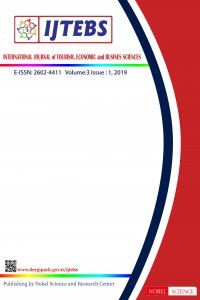CYCLING AS AN OPPORTUNITY FOR IMPROVING HEALTH TOURISM IN İZMİR
CYCLING AS AN OPPORTUNITY FOR IMPROVING HEALTH TOURISM IN İZMİR
Cycling, Bicycle Tourism Health Turizm, Special Interest Tourism, Eurovelo,
___
- Beioley, S. (1995). On yer bike – cycling and tourism, Insights. London, English Tourist Board, B-17/31.
- Buning, R.J. & Gibson H.J. (2016). The role of travel conditions in cycling tourism: Implications for destination and event management, Journal of Sport & Tourism. 20 (3-4), 175-193.
- Chen, K.H., Chang, F.H. & Tung, K.X. (2014). Measuring wellness‐related lifestyles for local tourists in Taiwan. Tourism Analysis. 19 (3), 369–376.
- Downward, P. and Lumsdon, L. (2001). The development of recreational cycle routes: an evaluation of user needs, Managing Leisure, 6, 50–60. DOI: 10.1080/1360671001002636
- Erten T.Ö. (2016). İzmir’in EuroVelo Bisikletli Turizm Ağı’na Katılım Süreci, Bisiklet Etkin Bir Ulaşım Aracı: Bursa Çalıştayı. Götschi, T., Garrard, J. &Giles-Corti B. (2016). Cycling as a Part of Daily Life: A Review of Health Perspectives, Transport Reviews. 36 (1), 45-71.
- Hall, C.M. (1992). Adventure, sport and health tourism. In C.M.Hall & B.Weiler (Eds.), Special Interest Tourism (141-158). London: Belhaven Press.
- Hall, C.M. (2011). Health and medical tourism: Kill or cure for global public health? TheTourist Review. 66, 4–15.
- Han, H., Meng, B. & Kim, W. (2017). Bike-traveling as a growing phenomenon: Role of attributes, value, satisfaction, desire, and gender in developing loyalty, Tourism Management. 59: 91-103, DOI: 10.1016/j.tourman.2016.07.013.
- Hillman, M. (1993). Cycling and the promotion of Health, Policy Studies, 14 (2), 49-58.
- http://www.bisim.com.tr/istasyonlar.aspx. Erişim: 08.07.2018.
- http://www.izto.org.tr/tr/izmirde-saglik-turizmi. Erişim 08.07.2018.
- https://www.fastcompany.com/3055053/germanys-62-mile-bike-autobahn-connects-10-cities. Erişim: 2018.
- https://www.theguardian.com/travel/2018/jul/05/10-great-long-distance-cycle-routes-europe-normandy-rome-readers-tips Lamont, M. &McKay, J. (2013). “Intimations of postmodernity in sports tourism at the Tour de France”, Journal of Sport & Tourism. 17 (4), 313-331.
- Lamont, M.J. (2009). Reinventing the wheel: A definitional discussion of bicycle tourism. Journal of Sport and Tourism. 14 (1), 5-23. Lee, C.F., Chen, P.T. & Huang, H. (2014). Attributes of Destination Attractiveness in Taiwanese Bicycle Tourism: The Perspective of Active Experienced Bicycle Tourists, International Journal of Hospitality & Tourism Administration. 15 (3), 275-297.
- DOI:10.1080/15256480.2014.925726 Lumsdon, L. (1996). Cycle tourism in Britain. Insights, March, 27-32. Available from the English Tourist Board. Lumsdon, L. (2000). Transport and tourism: Cycle tourism—a model for sustainable development? Journal of Sustainable Tourism. 8(5), 361–377.
- Medina‐Munoz, D.R. & Medina‐Munoz, R.D. (2013). Critical issues in health and wellness tourism: An exploratory study of visitors to wellness centres on Gran Canaria. Current Issues in Tourism. 16(5), 415–435. Oja, P., Bauman, A., de Geus, B., Krenn, P., Reger‐Nash, B. &Kohlberger, T. (2011). Health benefits of cycling: a systematic review, Medicine Science in Sport. 21(4), 496-509.
- Ormond, M. (2011). Medical tourism, medical exile: Responding to the cross‐border pursuit of healthcare in Malaysia. In Minca, C. & Oakes, T. (Eds.), Real tourism: Representation, practice and the ‘material’ in contemporary travel (pp. 143–161). London: Routledge. Pucher, J. &Dijkstra, L. (2003). “Promoting Safe Walking and Cycling to Improve Public Health: Lessons From The Netherlands and Germany”, American Journal of Public Health. 93 (9) 1509-1516.
- Ritchie, B.W. (1999). Bicycle tourism in the South Island of New Zealand. Unpublished Ph.D. Thesis, University of Otago, Dunedin, New Zealand.
- Ritchie, B.W. (1998).Bicycle tourism in the South Island of New Zealand: planning and management issues, Tourism Management.19 (6), December, 567-582.
- Ritchie, B.W. &Hall, M. (1999). Bicycle Tourism and Regional Development: A New Zealand Case Study, Anatolia - An International Journal of Tourism and Hospitality Research. 10 (2), 89-112.
- Schuett, M. & Holmes, T. (1996). Using a collaborative approach to developing a regional bicycle tourism plan. Journal of Hospitality and Leisure Marketing. 4(1), 83-95.
- Simeoni, F. &De Crescenzo, V. (2018). Ecomuseums (on Clean Energy), Cycle Tourism and Civic Crowdfunding: A New Match for Sustainability? Sustainability, 10, 817.
- Simonsen, P. & Jorgenson, B. (1998). Cycle tourism: An economic and environmental sustainable form of tourism? Unit of Tourism Research, Research Centre of Bornholm. Retrieved 3 December, 2006, from http://www.crt.dk/Pdf/Rep/0058.pdf
- Snelderwaard, A. (1996). The economic value of long distance cycle routes, Cycling without borders, towards a European network of long-distance cycle routes, International Colloquium. Bruges, 10–11 May, pp. 17–20.
- Solly, P. (2003). Cycle tourism - The perfect niche market for Australia: Submission to the Tourism Green Paper. Retrieved 4th November, 2005, from http://www.cyclingpromotionalliance.com.au/news/docs/Submission_to_Green_Paper_ Jul03.pdf
- South Australian Tourism Commission (2005). Cycle tourism strategy 2005- 2009. Paper presented at 17th Annual Council for Australian University Tourism. February.
- Standeven, J. & De Knop, P. (1999). Sport Tourism. Leeds: Human Kinetics.
- Sustrans. (1999). Cycle tourism information sheets. Erişim tarihi: 10.07.2018.
- http://www.sustrans.org.uk/assets/files/Info%20sheets/ff28.pdf
- Taylor, S. (2010). “Extending the Dream Machine’: Understanding people’s participation in mountain biking”, Annals of Leisure Research. 13 (1-2): 259-281.
- Whitaker, E. (2005). The Bicycle Makes the Eyes Smile: Exercise, Aging, and Psychophysical Well-Being in Older Italian Cyclists, Medical Anthropology Cross-Cultural Studies in Health and Illness. 24 (1), 1-43.
- Başlangıç: 2017
- Yayıncı: Nobel Bilim ve Araştırma Merkezi Limited
TARIM TURİZMİNİN DÜNYADA VE TÜRKİYE’DEKİ UYGULAMALARI
Aysun ÇELIK ÇANGA, Turgut KUTLU, Huriye ÇALIŞKAN
ÇATIŞMA YÖNETİM STİLLERİNİN GÖREV PERFORMANSINA ETKİSİ
İNSAN KAYNAKLARI YÖNETİMİNDE YENİ BİR SÜREÇ: YETENEK YÖNETİMİ
QUALITY PERCEPTIONS OF IRANIAN TOURISTS’ VISITING PROVINCE OF VAN / TURKEY
İbrahim ÇETİN, Zafer ÖTER, Fikret GÜRSES
Haluk TANRIVERDI, Dilbar GULIYEVA
MUHASEBE MESLEK MENSUPLARININ MUHASEBE STANDARTLARINI AKTARABİLMELERİ AÇISINDAN DEĞERLENDİRME
YEŞİL İŞLETMELER SÜRDÜRÜLEBİLİR TURİZM VE KARTEPE
Yüksel GÜNGÖR, Sami KARACAN, Esin KARACAN
HİZMET ÜRETİM MALİYETİ VE TMS 2 AÇISINDAN KONAKLAMA İŞLETMELERİ MALİYET KAYITLARI
SATIN ALMA DAVRANIŞLARINDA KADINLARIN GİYSİ MARKASI TERCİHLERİNİ ETKİLEYEN FAKTÖRLER
